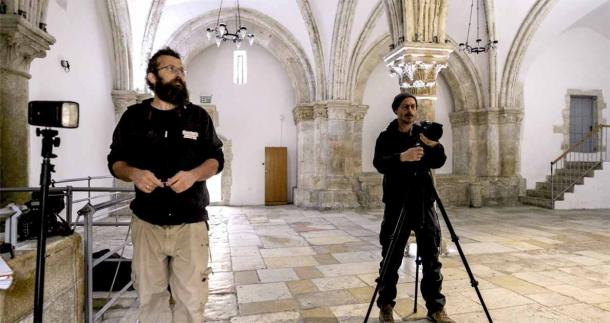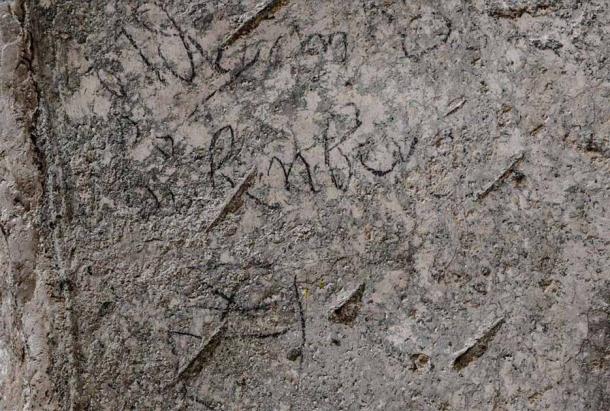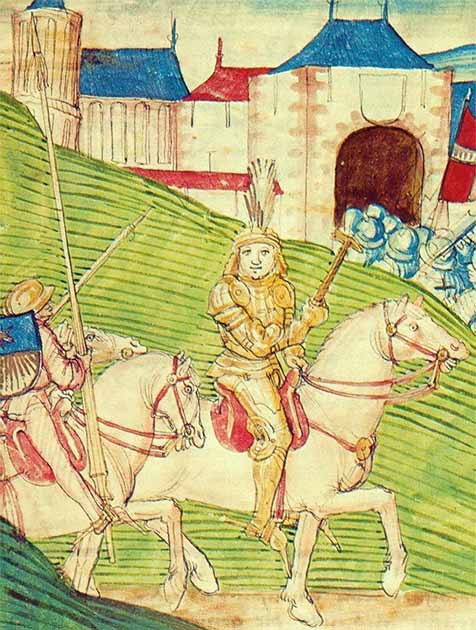A charcoal inscription has been identified at the alleged site of King David’s Tomb on Mount Zion in Jerusalem. Bearing the emblem of the Swiss family von Bubenberg, the Israel Antiquities Authority (IAA) says the pilgrim graffiti shows a direct link between medieval Switzerland and Jerusalem.
Extreme Devotion – The Medieval Pilgrimage
Born as the son of Heinrich IV von Bubenberg, Schultheiss of Bern and Lord of Spiez, Knight Adrian von Bubenberg was one of Switzerland’s most admired cultural heroes. After playing a pivotal role in defending Switzerland’s independence through the Middle Ages , Adrian undertook a pilgrimage to Jerusalem in 1466 AD. There, in the City of God, he became Knight of the Holy Sepulchre and took vows to defend the Church of the Holy Sepulchre , that was first constructed by Constantine the Great in the 4th century AD.
The Holy Sepulchre was believed to mark the spot where Jesus was crucified at Calvary (or Golgotha), and also Jesus’s empty tomb from which Christians maintain he was resurrected. Pilgrimages to the Holy Land were common between the death of Christ and the 15th century, and numerous accounts tell of the adventures of European knights undertaking this extreme form of Christian devotion.

IAA researchers surveying the King David’s Tomb building, on Mount Zion in Jerusalem. ( IAA)
I Woz Ere, In David’s Tomb
Project leaders Michael Chernin and Shai Halevi of the IAA said the new discoveries were made during research being conducted on the Judean Desert scrolls. IAA archaeologists were working at the King David’s Tomb Complex on Jerusalem’s Mount Zion, adjacent to the site traditionally associated with the Tomb of King David.
According to a report in The Times of Israel , during the Mamlik period (1332-1551 AD) the building served as a monastery and hostel for western pilgrims, “who left their mark on the walls”. The researchers first noticed patches of old faded graffiti and ancient inscriptions and they later worked out that they had been left behind by Christian and Muslim pilgrims visiting the holy site.

Charcoal graffiti thought to have been left by Knight Adrian von Bubenberg during his 15th century pilgrimage to Jerusalem. ( IAA)
Measuring the Marks of Medieval Knights
The building was originally constructed by Monks of the Franciscan monastic Order that was founded in 1209 AD by Saint Francis of Assisi, and that later became a Province of the Holy Land in 1217 AD. Now, the team of archaeologists has identified over 40 individual inscriptions in various languages and many of the timeworn marks bear the family emblems of medieval European knights .
IAA said interpreting the ancient marks was only possible with “new technological capabilities” including multispectral photography. Among the 40 discovered inscriptions is a charcoal drawn name and the heraldic emblem of von Bubenberg’s Swiss family and the researchers “hope” this is the mark of Knight Adrian von Bubenberg, the Swiss “national hero.” However, the team are showing caution as his son, Adrian (II) von Bubenberg, also made a pilgrimage to Jerusalem and “it is impossible to know for certain” who made the inscription.

Adrian von Bubenberg on horseback (Diebold Schilling the Elder). Was the graffiti left by the Swiss hero in the 15th century? ( Public Domain )
Either way, the discovery still demonstrates what the IAA archaeologists are calling a “direct link” between medieval Switzerland and Jerusalem. Eli Escusido, director of the IAA said the results of the recent research and this particular discovery “embraces religions and cultures worldwide.”
Perhaps Too Many Possibilities
In the Hebrew Bible King David is perhaps famous for slaying the Philistine giant Goliath, when he was a lad. And for later expanding Israel into a larger kingdom centred in Jerusalem. But even after reading all of this, the diligent researcher must bear in mind that many modern archaeologists argue David never even existed.
According to the Old Testament King David was buried within the “City of David” along with the kings of Judah after his reign. As Jerusalem grew from its original iron-age settlement into a large modern city many researchers assume these royal burial sites were destroyed. And since the late 18th century archaeologists have fiercely debated about the exact location of David’s tomb, and other early royal tombs .
According to LiveScience, “archaeological evidence for King David is limited,” and while his reign is traditionally dated from about 1000 to 962 BC, “when exactly he ruled is also uncertain.” Therefore, the headlines for this story should really read, the Swiss hero Adrian von Bubenberg “ possibly” left his mark in what is “ possibly” King David’s tomb.
Top image: Researchers at the Tomb of David building, examining what they hope is the mark of Adrian von Bubenberg. Source: IAA
By Ashley Cowie
Related posts:
Views: 0
 RSS Feed
RSS Feed















 October 22nd, 2022
October 22nd, 2022  Awake Goy
Awake Goy  Posted in
Posted in  Tags:
Tags: 
















